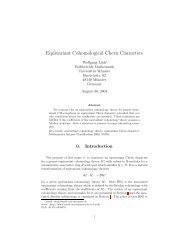Connes-Chern Character for Manifolds with Boundary and ETA ...
Connes-Chern Character for Manifolds with Boundary and ETA ...
Connes-Chern Character for Manifolds with Boundary and ETA ...
Create successful ePaper yourself
Turn your PDF publications into a flip-book with our unique Google optimized e-Paper software.
CONNES-CHERN CHARACTER AND <strong>ETA</strong> COCHAINS 5<br />
When M is even-dimensional <strong>and</strong> D ∂ is invertible, the equality between the above<br />
limit <strong>and</strong> the limit as t → ∞ yields, <strong>for</strong> any n = 2l ≥ m, the identity<br />
∑ 〈<br />
κ 2k (D), ch 2k (p F ) − ch 2k (p E ) 〉 + 〈 B b T/ch n+1<br />
∞ (D), ch n(p F ) − ch n (p E ) 〉 +<br />
0≤k≤l<br />
where<br />
+ 〈 T/ch n ∞ (D ∂), ch n (p F∂ ) − ch n (p E∂ ) 〉 =<br />
∫<br />
= Â( b ∇ 2 g) ∧ ( ch • (p F ) − ch • (p E ) ) ∫<br />
−<br />
b M<br />
+ 〈 B T/ch n ∞ (D ∂), T/ch n−1<br />
(h) 〉 ,<br />
ch 2k (p) =<br />
∂M<br />
Â(∇ 2 g ∂<br />
) ∧ T/ch •<br />
(h)<br />
{<br />
tr 0 (p), <strong>for</strong> k = 0,<br />
(−1) k (2k)!<br />
(<br />
tr<br />
k! 2k (p −<br />
1<br />
) ⊗ p⊗2k) , <strong>for</strong> k > 0.<br />
2<br />
(0.14)<br />
Like the Atiyah-Patodi-Singer index <strong>for</strong>mula [APS75], the equation (0.14) involves<br />
index <strong>and</strong> eta cochains, only of higher order. Moreover, the same type of identity<br />
continues to hold in the odd-dimensional case. Explicitly, it takes the <strong>for</strong>m<br />
(−1) n−1<br />
2<br />
( n−1<br />
2<br />
)<br />
!<br />
( 〈B b T/ch n+1<br />
∞ (D), (V −1 ⊗ V ) ⊗ n+1<br />
〉<br />
2 − (U −1 ⊗ U) ⊗ n+1<br />
2 +<br />
〈<br />
T/ch<br />
n<br />
∞ (D 〉 )<br />
∂), (V −1<br />
∂<br />
⊗ V ∂ ) ⊗ n+1<br />
2 − (U −1<br />
∂<br />
⊗ U ∂ ) ⊗ n+1<br />
2 =<br />
∫<br />
= Â( b ∇ 2 g) ∧ ( ch • (V ) − ch • (U) ) ∫<br />
− Â(∇ 2 g ∂<br />
) ∧ T/ch •<br />
(h)<br />
b M<br />
+ 〈 B T/ch n ∞ (D ∂), T/ch n−1<br />
(h) 〉 .<br />
∂M<br />
(0.15)<br />
The relationship between the relative pairing <strong>and</strong> the Atiyah-Patodi-Singer index<br />
theorem can actually be made explicit, <strong>and</strong> leads to interesting geometric consequences.<br />
Indeed, under the necessary assumption that M is even-dimensional, we show (cf.<br />
Theorem 7.6) that the above pairing can be expressed as follows:<br />
〈[D], [E, F, h]〉 = Ind APS D F − Ind APS D E + SF(h, D ∂ ); (0.16)<br />
here Ind APS st<strong>and</strong>s <strong>for</strong> the APS-index, <strong>and</strong> SF(h, D ∂ ) denotes the spectral flow along<br />
the path of operators ( ) h(s);<br />
D + ∂ D<br />
+<br />
∂<br />
is the restriction of c(dx)−1 D ∂ to the positive half<br />
spinor bundle <strong>and</strong> c(dx) denotes Clif<strong>for</strong>d multiplication by the inward normal vector.<br />
On applying the A-P-S index <strong>for</strong>mula [APS75, Eq. (4.3)], the pairing takes the explicit<br />
<strong>for</strong>m<br />
∫<br />
〈[D], [E, F, h]〉 = Â( b ∇ 2 g) ∧ ( ch • (F ) − ch • (E) )<br />
b M<br />
(<br />
)<br />
(0.17)<br />
− ξ(D +,F ∂<br />
∂<br />
) − ξ(D +,E ∂<br />
∂<br />
) + SF(h, D ∂ ),<br />
where<br />
ξ(D +,E ∂<br />
∂<br />
) = 1 (<br />
2<br />
η(D +,E ∂<br />
∂<br />
)<br />
) + dim Ker D +,E ∂<br />
∂<br />
. (0.18)

















